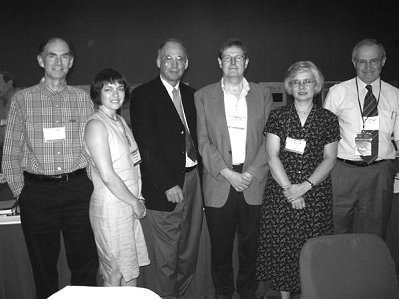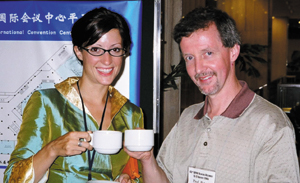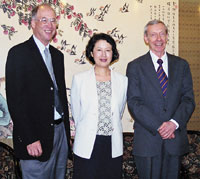
 |
 |
 |
 |
 |
 |
 |
 |
CNC-IUPAC News News Archives
IUPAC’s 43rd General Assembly in Beijing, China, August 2005
 |
Canadians
delegates to the IUPAC Council meeting:
|
IUPAC’s 43rd General Assembly in Beijing, China, in August 2005 was the first to be held in Asia and ran concurrently with the World Chemistry Congress organized around the theme “Innovation in Chemistry.” The Congress, organized by the Chinese Chemical Society and the Institute of Chemistry of the Chinese Academy of Sciences, attracted approximately 1100 attendees from around the world, with large representations from China and other Asian countries.
The opening of the General Assembly featured an address from IUPAC President Leiv Sydnes and awards of the 2004 and 2005 IUPAC Prizes for young chemists. Over the next 10 days, 411 participants from 52 countries took part in a demanding schedule of committee and division meetings. Young Observers from 9 countries, including three Canadians, added vitality and a valuable perspective to the sessions in which they participated. Following previous GAs, several young observers have become directly involved in IUPAC.
One of the highlights of the GA was the World Chemistry Leadership Meeting which brings together national leaders from chemical societies, chemical industry federations, and other organizations to discuss current issues in chemistry that have a potential international impact. The WCLMs are intended to encourage future IUPAC involvement in issues where the Union is in a unique position to provide support to the chemical community. The focal point of the meeting was a well-received talk on “Chemistry in Asia” by Prof. Goverdhan Mehta of the Indian Institute of Science, Bangalore and the incoming president of the International Council for Science. Among the issues he discussed were the increase in chemistry research in Asia, the pivotal role for chemistry in sustainable development, environmental concerns related to chemical industry and Asia’s growing share of chemical trade. Mehta’s presentation was followed by a wide-ranging discussion of the challenges and opportunities for chemistry in the century ahead.
A joint meeting of three IUPAC Committees focused on the public understanding of chemistry. The centerpiece of the meeting was the presentation of a preliminary report by Peter Mahaffy and his team on “Chemists and the Public: IUPAC’s Role in Achieving Mutual Understanding.” Mahaffy’s forceful presentation focused on the constructive and destructive interactions between the general public and IUPAC’s public. As he explained, the purpose of the project was to ask where IUPAC got it right and what needs improvement.
A stellar example of IUPAC’s far-reaching impact was a workshop organized by the Committee on Chemistry and Industry that brought together eight recent fellows of the Training Program for Safety and Environmental Protection to share their experiences. Through this program, operated jointly with UNESCO and UNIDO, individuals responsible for safety and environmental protection in developing countries are given free training at a major chemical facility. Fellows from Egypt, Nigeria, Turkey, Kenya, and Uruguay relayed inspiring stories of how they used their training to create safety programs in environments where safety is often a secondary consideration at best.
 |
Megane Rosborough and Peter Mahaffy (Vice Chair of the Committee on Chemistry Education) from King’s College, Edmonton worked on a project titled "Public Understanding of Science: Identifying IUPAC's Niche." |
The General Assembly concluded with a Council meeting at which Prof. Kazuko Matsumoto of Japan was elected vice president (president elect) for 2006–2007. Upon stepping in as president in 2008, she will become the second president from Japan and the first woman president since the Union was established in 1919. Canada will continue to play a key role in IUPAC during the next few years as Bryan Henry, University of Guelph, becomes President of IUPAC in January 2006. The final business of the Council was to approve a proposal to hold the 2009 Congress and General Assembly in Glasgow, Scotland.
 |
President Elect Bryan Henry (Canada), Vice President Elect Kazuko Matsumoto (Japan), and Secretary General David StC. Black (Australia).
|
Acknowledgement.
Pictures and information from the November issue of Chemistry International,
available on the following web site: http://www.iupac.org/publications/ci/